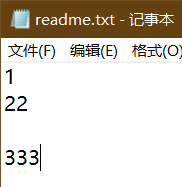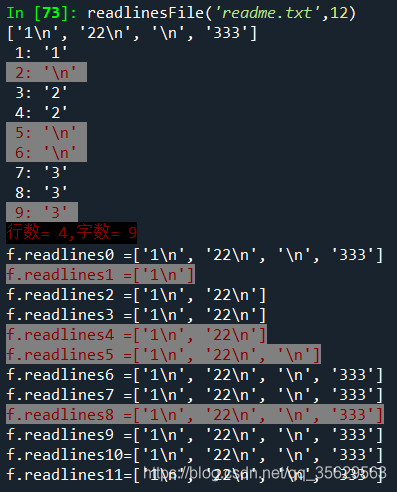readlines的幫助信息
>>> fr=open('readme.txt')
>>> help(fr.readlines)
Help on built-in function readlines:
readlines(hint=-1, /) method of _io.TextIOWrapper instance
Return a list of lines from the stream.
hint can be specified to control the number of lines read: no more
lines will be read if the total size (in bytes/characters) of all
lines so far exceeds hint.
Google翻譯
_io.TextIOWrapper 實(shí)例的 readlines(hint=-1, /) 方法
從流中返回行列表。
可以指定 hint 來(lái)控制讀取的行數(shù):如果到目前為止所有行的總大小(以字節(jié)/字符為單位)超過(guò)hint,則不會(huì)讀取更多行。
readme.txt中的內(nèi)容

>>> f=open('readme.txt')
>>> f.readlines()
['1\n', '22\n', '\n', '333']
為了進(jìn)一步搞清楚hint,我寫(xiě)了一個(gè)函數(shù)來(lái)演示
readlines函數(shù)代碼
def readlinesFile(filename,nbyte):
'''
探索f.readlines(i)中i的作用,典型的調(diào)用形式:
readlinesFile('readme.txt',12)
'''
for i in range(nbyte):
f=open(filename)
ss=f.readlines(i)
if i==0:#如果hint=0,先把每一個(gè)元素輸出
textline=len(ss)#文件的總行數(shù)
ntotalbyte=0#文件的總字?jǐn)?shù)
nwritebyte=0#已經(jīng)寫(xiě)了的字節(jié)數(shù)
for j in range(textline):
#nwritebyte=ntotalbyte#已經(jīng)寫(xiě)了的字節(jié)數(shù)
ntotalbyte=ntotalbyte+len(ss[j])
rowbyte=0#已經(jīng)寫(xiě)了的新行的字節(jié)數(shù),用來(lái)記一行已經(jīng)輸出的字節(jié)個(gè)數(shù)
while nwritebytentotalbyte:#當(dāng)已寫(xiě)字節(jié)總字節(jié)數(shù)
print(f'{nwritebyte+1}:',repr(ss[j][rowbyte])) #repr是為了輸出換行符
nwritebyte=nwritebyte+1
rowbyte=rowbyte+1
print(f'行數(shù)={textline},字?jǐn)?shù)={ntotalbyte}')
print(f'f.readlines{i}={ss}')
f.close()
輸出
>>> readlinesFile('readme.txt',12)
1: '1'
2: '\n'
3: '2'
4: '2'
5: '\n'
6: '\n'
7: '3'
8: '3'
9: '3'
行數(shù)=4,字?jǐn)?shù)=9
f.readlines0=['1\n', '22\n', '\n', '333']
f.readlines1=['1\n']
f.readlines2=['1\n', '22\n']
f.readlines3=['1\n', '22\n']
f.readlines4=['1\n', '22\n']
f.readlines5=['1\n', '22\n', '\n']
f.readlines6=['1\n', '22\n', '\n', '333']
f.readlines7=['1\n', '22\n', '\n', '333']
f.readlines8=['1\n', '22\n', '\n', '333']
f.readlines9=['1\n', '22\n', '\n', '333']
f.readlines10=['1\n', '22\n', '\n', '333']
f.readlines11=['1\n', '22\n', '\n', '333']
總結(jié):
1.hint 是要輸出顯示的字節(jié)數(shù)
2.hint 默認(rèn)等于-1,就是以列表的形式讀出所有內(nèi)容
3.hint = 0時(shí),效果等同于-1
4.hint 所指的字節(jié)數(shù)正好是換行符的話(huà),則實(shí)際輸出是 hint+1
更花哨的readlinesFile
def readlinesFile(filename,nbyte):
'''
探索f.readlines(i)中i是指什么,典型的調(diào)用形式:
readlinesFile('readme.txt',12)
'''
specialByte=[]#存儲(chǔ)特殊的字節(jié)數(shù)用
for i in range(nbyte):
with open(filename) as f:#使用with語(yǔ)句就可以不使用f.close()了
ss=f.readlines(i)
if(i==0):#如果hint=0,先把每一個(gè)元素輸出
print(ss)
textline=len(ss)#文件的總行數(shù)
ntotalbyte=0#文件的總字?jǐn)?shù)
nwritebyte=0#已經(jīng)寫(xiě)了的字節(jié)數(shù)
for j in range(textline):
#nwritebyte=ntotalbyte#已經(jīng)寫(xiě)了的字節(jié)數(shù)
ntotalbyte=ntotalbyte+len(ss[j])
rowbyte=0#已經(jīng)寫(xiě)了的新行的字節(jié)數(shù),用來(lái)記一行已經(jīng)輸出的字節(jié)個(gè)數(shù)
while nwritebytentotalbyte:#當(dāng)已寫(xiě)字節(jié)總字節(jié)數(shù)
if(nwritebyte is ntotalbyte-1):
specialByte.append(nwritebyte)
print(f'\033[0;31;47m{nwritebyte+1:2d}:',repr(ss[j][rowbyte]),'\033[0m')#\033[0m是字體和背景顏色設(shè)置,注意可能需要其他庫(kù)的支持
else:
print(f'{nwritebyte+1:2d}:',repr(ss[j][rowbyte]))
nwritebyte=nwritebyte+1
rowbyte=rowbyte+1
print(f'\033[0;31;40m行數(shù)={textline:2d},字?jǐn)?shù)={ntotalbyte:2d}\033[0m')
if i in specialByte:
print(f'\033[0;31;47mf.readlines{i:2d}={ss}\033[0m') #是左對(duì)齊
else:
print(f'f.readlines{i:2d}={ss}') #是左對(duì)齊
效果

參考文章:https://www.jb51.net/article/206578.htm
到此這篇關(guān)于關(guān)于python中readlines函數(shù)的參數(shù)hint的相關(guān)知識(shí)總結(jié)的文章就介紹到這了,更多相關(guān)python readlines函數(shù)內(nèi)容請(qǐng)搜索腳本之家以前的文章或繼續(xù)瀏覽下面的相關(guān)文章希望大家以后多多支持腳本之家!
您可能感興趣的文章:- Python 整行讀取文本方法并去掉readlines換行\(zhòng)n操作
- python: line=f.readlines()消除line中\(zhòng)n的方法
- Python File readlines() 使用方法
- 詳談python read readline readlines的區(qū)別
- Python中read()、readline()和readlines()三者間的區(qū)別和用法
- Python中read,readline和readlines的區(qū)別案例詳解